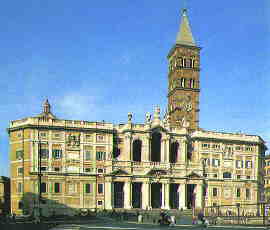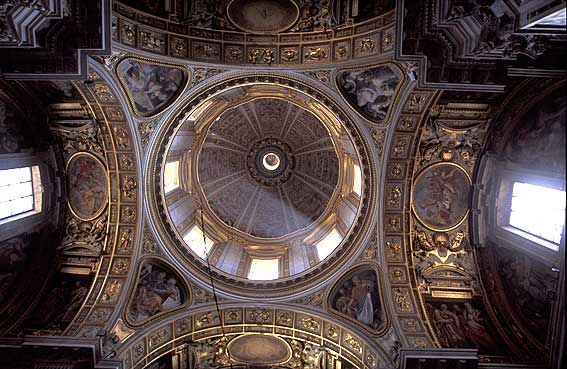This DVD would have
to be one of my Desert Island Discs
– that is assuming I had a DVD player
on the island! The reason is not hard
to see. Three things come together to
make this a dream disc for enthusiasts
of 16th century polyphonic
music.
Firstly we have a glorious
performance of some of most gorgeous
music ever composed! Secondly there
is the setting – the most beautiful
(in my opinion) church in Rome, if not
the world. And finally the singers are
perhaps the greatest exponents of Renaissance
music in the world. If you are in any
doubt about this just ask yourself the
question – ‘Why did the Vatican ask
an English choir to celebrate the 400th
Anniversary of that most Roman composer
Giovanni Pierluigi da Palestrina?’
Let’s consider the
singers first. They were founded over
thirty years ago by their present director
Peter Phillips. Currently they have
some 47 CDs available covering the entire
range of Renaissance sacred music. What
is perhaps most striking is their director’s
willingness to explore the byways as
well as the highways of the repertoire.
Just listen to their releases of music
by William Cornysh, Manuel Cardoso and
Robert Whyte to see what wonderful music
they have added to the canon. This is
over and above the better known works
by William Byrd, Tomás Luis de
Victoria, Thomas Tallis – and of course
Palestrina.
The sound of the ‘Scholars’
is unique. The quality of recording
by Gimell allows every nuance to be
heard. There is definitive clarity of
sound on this DVD which gives clear
‘visibility’ of the progression of the
musical parts. The underlying scholarship
allows the choir to fully understand
the music they sing and this comes across
in every note.
Palestrina is a big
name. He ranks with Byrd, Victoria and
Orlando Lassus as being one of the great
masters of Renaissance sacred music.
This is not really the place to give
a detailed history of his life and career.
However a few comments are relevant
whilst considering this disc.
Appropriately, Palestrina
began his education as a scholar at
St Maria Maggiore where he was also
a choir boy. After finishing his education
he returned to the suburban town of
Palestrina (hence his name). After marriage
and fathering three children he returned
to Rome where he took up a number of
appointments including singing in the
Sistine Chapel. Later he became ‘Maestro
di cappella’ of St John’s Lateran (1555-1560)
and St Maria Maggiore (1561-1566), his
old alma mater.
His reputation as a
composer who was approved of by the
Vatican hierarchy led to various important
ecclesiastical projects. Chief among
these was the rewriting of the church’s
plainsong books following the deliberations
of the Council of Trent. His most famous
work is probably the Missa Papae
Marcelli which is rumoured to have
been written to mollify Pope Marcellus
II and his insistence that all music
must contribute to the whole ceremony
of the mass and must not dominate or
overshadow it.
A brief look at a catalogue
of Palestrina’s works reveals him to
be extremely prolific. He wrote a huge
amount of ecclesiastical (and other)
music in a basically conservative manner.
The key elements of his style are the
perfect balance of the voices and the
total coherence of the musical structure
both ‘vertically and horizontally’.
His polyphonic style became the norm
that was imitated for many years. Even
today there are classes in writing counterpoint
in the style of Palestrina.
The music on this DVD
includes the great Missa Papae Marcelli
mentioned above. This is a long work
that lasts for over half an hour. It
is often forgotten that the Tridentine
Mass was much less audience orientated
than modern post Vatican II revisions.
There was not the dialogue between priest
and people. Most of the words of the
liturgy were spoken silently or quietly
by the celebrant. So the music of the
mass was used to ‘entertain’ the audience.
But the presentation on this DVD is
divorced from the liturgical setting.
This is certainly a concert performance.
Other works included
are the Stabat Mater which is
perhaps one of Palestrina’s greatest
works. It is his last loosely datable
composition and is a kind of summing
up of his musical achievement. The attractive
Magnificat and Nunc Dimitis
is a positive and bright example of
these setting from Vespers. The Alma
Redemptoris has a rare simplicity
which belies its subtle beauty. The
Surge illuminare is a fine example
of an antiphonal setting for two choirs.
One other work, not
by the ‘master’ is Allegri’s ubiquitous
Miserere. This is the work that
Mozart famously copied down from memory
after a visit to the Sistine Chapel.
It is given a stunning performance here.
In spite of its popularity it never
ceases to amaze and impress me.

The setting of the concert is the strikingly
beautiful and sumptuous St Maria Maggiore.
This is one of the Four Great Basilicas
in Rome. The story of its foundation
is well known but bears repetition.
In 352 AD Pope Liberius dreamt of a
snowstorm in the month of August. The
dream came true and he vowed to build
a church at the place he had dreamt
of. Originally it was called ‘Santa
Maria a Nives’ – St Mary of the Snow.
The church was rebuilt in 432 AD by
Pope Sixtus III. Of course the church
has been restored, added to and rearranged
many time since but the important fact
is that it is very much as Palestrina
would have remembered it – so it is
highly appropriate for this recording.
The DVD gives us two options for enjoying
the concert. The first is to concentrate
on the music - this is 100% Tallis Scholars
with optional subtitles. The second
way of appreciating this recording is
to watch the exposition of gorgeous
art works, mosaics and carvings illustrate
the texts of the sung works. This is
a church is full of masterpieces; some
of the most gorgeous and moving religious
imagery in the world are encompassed
in these four walls.
Additional features
of this fine DVD include an extra ‘audio
only’ selection of two of Palestrina’s
greatest works – the glorious Missa
Assumpta est Maria and the ‘not
so short’ Missa Brevis. These
were recorded in the United Kingdom
(see above).
There is also a fascinating
short film of ‘what the singers see;’
whilst listening to the Nunc Dimitis
we can see Peter Phillips direct the
action!
This is a big value
recording. When the times are all added
up we have over eighty minutes of music
on film and nearly an extra hour of
audio. Add to this the wonderful film
of the Basilica’s treasure and the excellent
program notes we have a tremendous product.
It is highly appropriate
to have such a stunning record of this
fine 400th birth (death)day
concert. It is a tribute to the competence
and the scholarly integrity of the Tallis
Scholars that they were asked to do
the birthday honours in Palestrina’s
own church in front of the Vatican hierarchy.
John France


